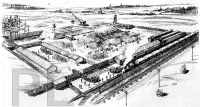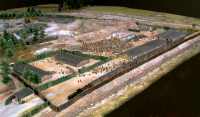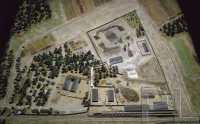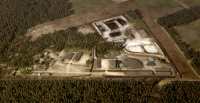Each historic model presents its very own research approach and reconstruction methods.
In this respect the Treblinka model which I made for the "Gisozi Genocide Memorial" in Kigali
(Rwanda) was even more challenging than most.
Observe the two examples below, which illustrate how a historic scale modeller may
go about reinterpreting a historic building, event or site.
Only a few aspects of the camps features could be reconstrued with certain accuracy, one of which
was the zoo and surrounding barracks which was situated within the campsí administration section.
From these photographs many of the camp features were scaled and reconstrued and where
applicable, detail added.
 |
| Treblinka Zoo - Original Photo |
 |
| Treblinka Zoo - my Model |
A rare photograph (left) of the zoo structure was available and from this a reconstructed scaled
drawing on computer was first made. This was then used to construct the 15 mm high (1:400 scale) zoo
structure as a separate unit which was later added in position, together with the other barracks
(right). A photo in the model roughly from the same viewpoint as the original photo.†
 |
| Willenberg Drawing |
 |
| Treblinka Arrival |
Also for instance a drawing by survivor Samuel Willenberg was used as an invaluable
aid to reconstruct the Arrival and Sorting area of the camp.
 |
| My Treblinka Model |
 |
| Treblinka - BBC TV virtual Image |
My best accolade so far; based on my extensive research for this model, the BBC TV
approached me via the ARC website in order to assist them with information regarding the
virtual reconstruction of Treblinka. This they used to generated 3D computer virtual imagery
of the camp as part of their documentary on the Holocaust (2005).
© Peter Laponder 2006





